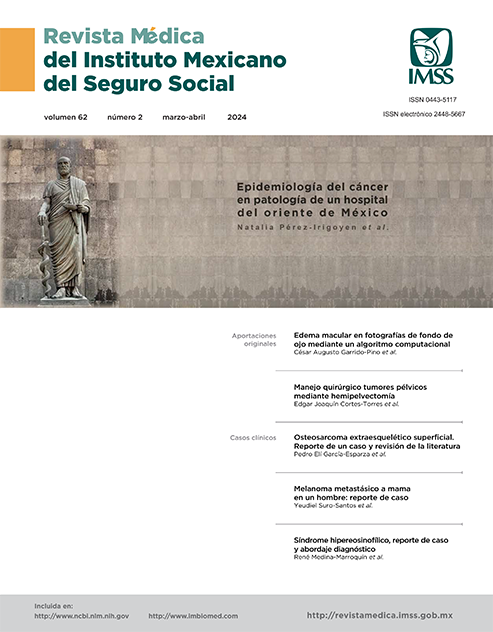Síndrome de trisomía parcial de 9p: ampliando el fenotipo
##plugins.themes.themeEleven.article.main##
Palabras clave
Trisomía, Cromosomas Humanos, Cardiopatías Congénitas, Cariotipo
Resumen
Introducción: la trisomía del brazo corto del cromosoma 9 (9p) es la cuarta cromosomopatía más frecuente. Se trata de una anomalía estructural autosómica, parcial o completa, del brazo corto del cromosoma 9. Generalmente es causada por una translocación recíproca parental entre el cromosoma 9 y otro autosoma, es poco frecuente la alteración genética espontánea (de novo). Presenta gran variabilidad fenotípica debido al tamaño variable del fragmento de cromosoma involucrado.
Caso clínico: presentamos el caso de una paciente con diagnóstico de trisomía del brazo corto del cromosoma 9 con un cariotipo con un complemento cromosómico 46,XX,add(9)(p24), interpretándose como un fragmento cromosómico adicional en el cromosoma 9p. Se realizó estudio de microarreglo, el cual reportó que la región 9p24.3-p13.1 se encuentra en triple dosis, lo que corresponde a una trisomía parcial 9p o síndrome de Rethoré, la cual es una entidad de baja prevalencia, con una expresividad y pronóstico variable. En el presente caso, el hallazgo de un soplo y diagnóstico de estenosis de la válvula pulmonar fue el abordaje inicial; la cardiopatía descrita en nuestra paciente no ha sido reportada en la literatura como parte del cuadro clínico, provocando que no fuera una sospecha diagnóstica de forma inicial.
Conclusión: a pesar de tener descrito un fenotipo ya definido, se deben considerar otros datos clínicos que no estén documentados, y al encontrarse nueva evidencia clínica, reportarse y con ello lograr ampliar el fenotipo para un diagnóstico oportuno.
Referencias
Dhangar S, Korgaonkar S, Vundinti BR. Partial trisomy 9 (9pter->9q22.1) and partial monosomy 14 (14pter->14q11.2) due to paternal translocation t(9;14)(q22.1;q11.2) in a case of dysmorphic features. Intractable Rare Dis Res. 2019;8(1):72-7.
Pazmiño-Miranda AM, Carvajal-García MF, Velastegui-Ayala EM, et al. Trisomía 9: primer caso clínico neonatal reportado en el Ecuador. Pediatria. 2023;56(1):1-4.
Luna-Barrón B, Taboada-López G, Siacar-Bacarreza S, et al. Trisomía 9: Reporte de un caso. Cuadernos. 2019;60(1):37-40.
Vaglio A, Búrix B, Quadrelli A, et al. Síndrome de trisomía 9p: características. Seguimiento de doce años. Arch Pediatr Urug. 2007;78(2):151-6.
Cammarata-Scalisi F. Trisomía 9p. Una breve descripción clínica, diagnóstica y terapéutica. Arch Argent Pediatr. 2019;117(5):473-6.
Mohamed AM, Kamel AK, Eid MM, et al. Chromosome 9p terminal deletion in nine Egyptian patients and narrowing of the critical region for trigonocephaly. Mol Genet Genomic Med. 2021;9(11).
Alfi O, Donnell G, Allderdice P, et al. The 9p- syndrome. Ann Genet. 1976;19(1):11-6. doi: 10.1136/jmg.16.1.75.
Brambila-Tapia AJ, Neira VA, Vásquez-Velásquez AI, et al. Pure 9p trisomy derived from a terminal balanced unreciprocal translocation. Genetic Counseling. 2014;25(3):289-97.
Stagi S, Lapi E, Seminara S, et al. Long-term auxological and endocrinological evaluation of patients with 9p trisomy: a focus on the growth hormone-insulin-like growth factor-I axis. BMC Endocr Disord. 2014;14(3):1-10. Disponible en: http://www.biomedcentral.com/1472-6823/14/3.
Canton APM, Nishi MY, Furuya TK, et al. Good response to long-term therapy with growth hormone in a patient with 9p trisomy syndrome: A case report and review of the literature. Am J Med Genet A. 2016;170(4):1046-9.
Kuan CY, Tai CJ, Shyu IL, et al. A de novo partial trisomy 9p with Dandy-Walker malformation and ventriculomegaly. Taiwan J Obstet Gynecol. 2022;61(6):1077-81.
Littooij AS, Hochstenbach R, Sinke RJ, et al. Two cases with partial trisomy 9p: Molecular cytogenetic characterization and clinical follow-up. Am J Med Genet. 2002;109(2):125-32.
Henningsen MB, Gulisano HA, Bjarkam CR. Congenital hydrocephalus in a trisomy 9p gained child: a case report. J Med Case Rep. 2022;16(1).
Abdallah-Bouhjar IB, Hannachi H, Mougou-Zerelli S, et al. Array-CGH study of partial trisomy 9p without mental retardation. Am J Med Genet A. 2011;155(7):1735-9.
Huret JL, Leonard C, Forestier B, et al. Eleven new cases of del(9p) and features from 80 cases. Journal of Medical Genetics. 1988;25:741-9. Disponible en: http://www.scielo.org.bo/scielo.php?script=sci_arttext&pid=S1652-67762019000100006&lng=es.
Lengyel A, Kosik A, Pinti É, et al. Trisomy 9p and clinical heterogeneity: Case report of an unusual presentation. Orv Hetil. 2018;159(47):1994-2000.
Temtamy SA, Kamel AK, Ismail S, et al. Phenotypic and cytogenetic spectrum of 9P trisomy. Genetic Counseling. 2007;18(1):29-48.
Juan Xie, Jianlin Z, Yimei Y, et al. Diagnosis of a case with partial 9p trisomy by next generation sequencing. Chin J Med Genet. 2018;35(6):852-5.
Sams EI, Ng JK, Tate V, et al. From karyotypes to precision genomics in 9p deletion and duplication syndromes. Human Genetics and Genomics Advances. 2022;3(1).
Jelin A, Perry H, Hogue J, et al. Clefting in trisomy 9p patients: Genotype-phenotype correlation using microarray comparative genomic hybridization. Journal of Craniofacial Surgery. 2010;21(5):1376-9.
Al Achkar W, Wafa A, Moassass F, et al. Partial trisomy 9p22 to 9p24.2 in combination with partial monosomy 9pter in a Syrian girl. Mol Cytogenet. 2010;3(18). Disponible en: http://www.molecularcytogenetics.org/content/3/1/18.


